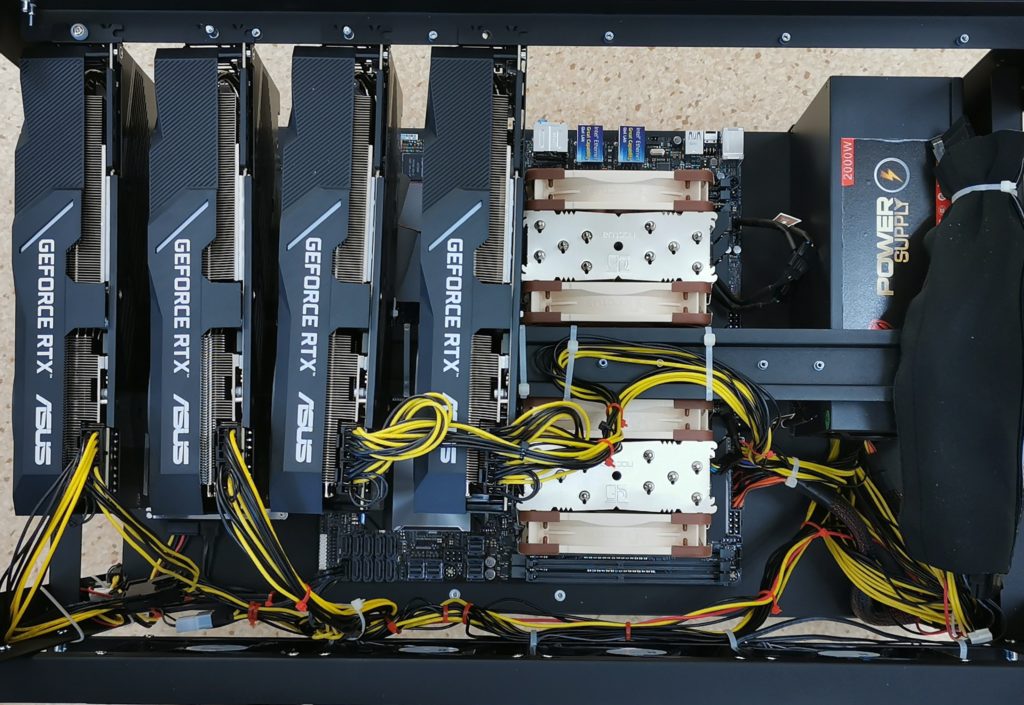The Hashkiller 4×2080 hardware specification:
Hashkiller 4×2080 benchmark
D:\Hashcat\hashcat-5.1.0>hashcat64.exe -b -w 3 -O
hashcat (v5.1.0) starting in benchmark mode...
OpenCL Platform #1: NVIDIA Corporation
======================================
* Device #1: GeForce RTX 2080, 2048/8192 MB allocatable, 46MCU
* Device #2: GeForce RTX 2080, 2048/8192 MB allocatable, 46MCU
* Device #3: GeForce RTX 2080, 2048/8192 MB allocatable, 46MCU
* Device #4: GeForce RTX 2080, 2048/8192 MB allocatable, 46MCU
Benchmark relevant options:
===========================
* --optimized-kernel-enable
* --workload-profile=3
Hashmode: 0 - MD5
Speed.#1.........: 40818.6 MH/s (37.05ms) @ Accel:32 Loops:1024 Thr:1024 Vec:4
Speed.#2.........: 40892.3 MH/s (36.99ms) @ Accel:32 Loops:1024 Thr:1024 Vec:4
Speed.#3.........: 40732.2 MH/s (37.12ms) @ Accel:32 Loops:1024 Thr:1024 Vec:4
Speed.#4.........: 40644.5 MH/s (37.19ms) @ Accel:32 Loops:1024 Thr:1024 Vec:4
Speed.#*.........: 163.1 GH/s
Hashmode: 100 - SHA1
Speed.#1.........: 13087.2 MH/s (58.07ms) @ Accel:64 Loops:512 Thr:512 Vec:2
Speed.#2.........: 13071.3 MH/s (58.09ms) @ Accel:64 Loops:512 Thr:512 Vec:2
Speed.#3.........: 13009.8 MH/s (58.38ms) @ Accel:64 Loops:512 Thr:512 Vec:2
Speed.#4.........: 13008.4 MH/s (58.38ms) @ Accel:64 Loops:512 Thr:512 Vec:2
Speed.#*.........: 52176.7 MH/s
Hashmode: 1400 - SHA2-256
Speed.#1.........: 5607.4 MH/s (67.78ms) @ Accel:32 Loops:256 Thr:1024 Vec:1
Speed.#2.........: 5604.6 MH/s (67.82ms) @ Accel:32 Loops:256 Thr:1024 Vec:1
Speed.#3.........: 5593.3 MH/s (67.92ms) @ Accel:32 Loops:256 Thr:1024 Vec:1
Speed.#4.........: 5578.1 MH/s (68.12ms) @ Accel:32 Loops:256 Thr:1024 Vec:1
Speed.#*.........: 22383.4 MH/s
Hashmode: 1700 - SHA2-512
Speed.#1.........: 1790.1 MH/s (66.19ms) @ Accel:64 Loops:64 Thr:640 Vec:1
Speed.#2.........: 1791.6 MH/s (66.14ms) @ Accel:64 Loops:64 Thr:640 Vec:1
Speed.#3.........: 1788.5 MH/s (66.18ms) @ Accel:64 Loops:64 Thr:640 Vec:1
Speed.#4.........: 1784.9 MH/s (66.35ms) @ Accel:64 Loops:64 Thr:640 Vec:1
Speed.#*.........: 7155.2 MH/s
Hashmode: 2500 - WPA-EAPOL-PBKDF2 (Iterations: 4096)
Speed.#1.........: 622.1 kH/s (74.12ms) @ Accel:32 Loops:128 Thr:1024 Vec:1
Speed.#2.........: 622.1 kH/s (74.15ms) @ Accel:32 Loops:128 Thr:1024 Vec:1
Speed.#3.........: 622.6 kH/s (74.04ms) @ Accel:32 Loops:128 Thr:1024 Vec:1
Speed.#4.........: 619.5 kH/s (74.41ms) @ Accel:32 Loops:128 Thr:1024 Vec:1
Speed.#*.........: 2486.3 kH/s
Hashmode: 1000 - NTLM
Speed.#1.........: 68330.2 MH/s (21.52ms) @ Accel:32 Loops:1024 Thr:1024 Vec:2
Speed.#2.........: 68197.1 MH/s (21.48ms) @ Accel:32 Loops:1024 Thr:1024 Vec:2
Speed.#3.........: 61400.5 MH/s (22.28ms) @ Accel:32 Loops:1024 Thr:1024 Vec:2
Speed.#4.........: 68032.5 MH/s (21.47ms) @ Accel:32 Loops:1024 Thr:1024 Vec:2
Speed.#*.........: 266.0 GH/s
Hashmode: 3000 - LM
Speed.#1.........: 35146.5 MH/s (42.93ms) @ Accel:128 Loops:1024 Thr:256 Vec:1
Speed.#2.........: 35222.2 MH/s (42.78ms) @ Accel:128 Loops:1024 Thr:256 Vec:1
Speed.#3.........: 34921.1 MH/s (43.04ms) @ Accel:128 Loops:1024 Thr:256 Vec:1
Speed.#4.........: 35261.2 MH/s (42.77ms) @ Accel:128 Loops:1024 Thr:256 Vec:1
Speed.#*.........: 140.6 GH/s
Hashmode: 5500 - NetNTLMv1 / NetNTLMv1+ESS
Speed.#1.........: 38220.9 MH/s (39.20ms) @ Accel:32 Loops:1024 Thr:1024 Vec:1
Speed.#2.........: 38213.9 MH/s (39.18ms) @ Accel:32 Loops:1024 Thr:1024 Vec:1
Speed.#3.........: 38178.6 MH/s (39.20ms) @ Accel:32 Loops:1024 Thr:1024 Vec:1
Speed.#4.........: 38168.3 MH/s (39.23ms) @ Accel:32 Loops:1024 Thr:1024 Vec:1
Speed.#*.........: 152.8 GH/s
Hashmode: 5600 - NetNTLMv2
Speed.#1.........: 2615.6 MH/s (72.70ms) @ Accel:32 Loops:128 Thr:1024 Vec:1
Speed.#2.........: 2615.4 MH/s (72.66ms) @ Accel:32 Loops:128 Thr:1024 Vec:1
Speed.#3.........: 2615.3 MH/s (72.64ms) @ Accel:32 Loops:128 Thr:1024 Vec:1
Speed.#4.........: 2611.8 MH/s (72.72ms) @ Accel:32 Loops:128 Thr:1024 Vec:1
Speed.#*.........: 10458.1 MH/s
Hashmode: 1500 - descrypt, DES (Unix), Traditional DES
Speed.#1.........: 1406.0 MH/s (68.00ms) @ Accel:8 Loops:1024 Thr:256 Vec:1
Speed.#2.........: 1412.5 MH/s (67.66ms) @ Accel:8 Loops:1024 Thr:256 Vec:1
Speed.#3.........: 1402.8 MH/s (68.11ms) @ Accel:8 Loops:1024 Thr:256 Vec:1
Speed.#4.........: 1414.7 MH/s (67.53ms) @ Accel:8 Loops:1024 Thr:256 Vec:1
Speed.#*.........: 5636.1 MH/s
Hashmode: 500 - md5crypt, MD5 (Unix), Cisco-IOS $1$ (MD5) (Iterations: 1000)
Speed.#1.........: 12552.6 kH/s (80.76ms) @ Accel:1024 Loops:1000 Thr:32 Vec:1
Speed.#2.........: 12580.4 kH/s (80.01ms) @ Accel:1024 Loops:1000 Thr:32 Vec:1
Speed.#3.........: 12464.2 kH/s (80.87ms) @ Accel:1024 Loops:1000 Thr:32 Vec:1
Speed.#4.........: 12524.5 kH/s (79.15ms) @ Accel:1024 Loops:1000 Thr:32 Vec:1
Speed.#*.........: 50121.7 kH/s
Hashmode: 3200 - bcrypt $2*$, Blowfish (Unix) (Iterations: 32)
Speed.#1.........: 19211 H/s (37.26ms) @ Accel:16 Loops:4 Thr:8 Vec:1
Speed.#2.........: 19595 H/s (36.40ms) @ Accel:16 Loops:4 Thr:8 Vec:1
Speed.#3.........: 19313 H/s (36.95ms) @ Accel:16 Loops:4 Thr:8 Vec:1
Speed.#4.........: 19603 H/s (36.40ms) @ Accel:16 Loops:4 Thr:8 Vec:1
Speed.#*.........: 77723 H/s
Hashmode: 1800 - sha512crypt $6$, SHA512 (Unix) (Iterations: 5000)
Speed.#1.........: 275.4 kH/s (67.21ms) @ Accel:512 Loops:128 Thr:32 Vec:1
Speed.#2.........: 274.4 kH/s (67.46ms) @ Accel:512 Loops:128 Thr:32 Vec:1
Speed.#3.........: 275.4 kH/s (67.20ms) @ Accel:512 Loops:128 Thr:32 Vec:1
Speed.#4.........: 273.4 kH/s (67.71ms) @ Accel:512 Loops:128 Thr:32 Vec:1
Speed.#*.........: 1098.5 kH/s
Hashmode: 7500 - Kerberos 5 AS-REQ Pre-Auth etype 23
Speed.#1.........: 466.8 MH/s (51.14ms) @ Accel:128 Loops:64 Thr:64 Vec:1
Speed.#2.........: 474.0 MH/s (50.33ms) @ Accel:128 Loops:64 Thr:64 Vec:1
Speed.#3.........: 465.8 MH/s (51.25ms) @ Accel:128 Loops:64 Thr:64 Vec:1
Speed.#4.........: 474.2 MH/s (50.33ms) @ Accel:128 Loops:64 Thr:64 Vec:1
Speed.#*.........: 1880.8 MH/s
Hashmode: 13100 - Kerberos 5 TGS-REP etype 23
Speed.#1.........: 463.3 MH/s (51.53ms) @ Accel:128 Loops:64 Thr:64 Vec:1
Speed.#2.........: 471.5 MH/s (50.67ms) @ Accel:128 Loops:64 Thr:64 Vec:1
Speed.#3.........: 460.6 MH/s (51.79ms) @ Accel:128 Loops:64 Thr:64 Vec:1
Speed.#4.........: 469.8 MH/s (50.78ms) @ Accel:128 Loops:64 Thr:64 Vec:1
Speed.#*.........: 1865.2 MH/sHashkiller 4×2080 photo gallery



Moja ojczyzna
Projekt o charakterze patriotyczno-edukacyjnym dla najmłodszych, wykonany w ramach pracy dyplomowej przez inż. Jakuba Chachułę i inż. Marcina Tillaka.
Metody deanonimizacji użytkowników wybranych kryptowalut na przykładzie bitcoina
Celem artykułu jest przedstawienie metod umożliwiających deanonimizację użytkowników kryptowalut na przykładzie najpopularniejszej z nich — bitcoina. Na wstępie przedstawiono podstawowe pojęcia oraz zasadę działania tej kryptowaluty, po czym dokonano autorskiej systematyzacji typów transakcji wzbogaconej o wykresy ukazujące ich ilościowe występowanie w łańcuchu bloków. W głównej części pracy przedstawiono heurystyki wykorzystywane przy deanonimizacji użytkowników. Następnie skupiono się na praktycznych wskazówkach ułatwiających implementację omówionych heurystyk w rzeczywistym systemie deanonimizacyjnym. Pokazane zostały także rzeczywiste scenariusze wykorzystania heurystyk wzbogacone o komentarze będące wynikiem doświadczeń płynących z przeprowadzonych przez autorów ekspertyz. W ostatniej części wskazano uwarunkowania prawne oraz istniejące narzędzia wspomagające przeprowadzanie czynności deanonimizacyjnych.
Deanonymization of bitcoin cryptocurrency users
The aim of this article is to show how one can deanonymize users of cryptocurrencies. To this end the most popular of the cryptocurrencies, i.e. bitcoin is used as an example. At the beginning, the basic concepts about cryptocurrencies are presented. Afterwards, our approach to systematize the types of transactions existing in the blockchain is proposed. This part is enriched with the graphs showing their quantitative occurrence in the blockchain. The main part of this article presents the heuristics use to deanonymize users. A few practical pieces of advice for implementation of the presented heuristics in the real deanonymizing system are included. Then the real case studies are introduced. They are supported with comments based on the experience from court trials carried out by the authors. The final part contains legal regulations and existing tools supporting the deanonymizing process.
DOI: 10.5604/01.3001.0013.1466
GICID: 01.3001.0013.1466
Biuletyn WAT 2019; 68 (1): 51-77
Link: https://biuletynwat.pl/resources/html/article/details?id=188205